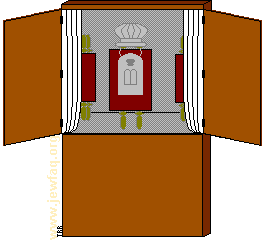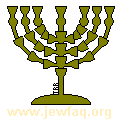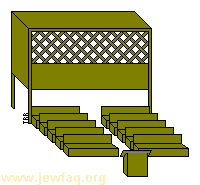Synagogues, Shuls and Temples
Level: Basic
|
• A Jewish "church" is called a synagogue, shul or temple
• A synagogue is a place of worship and study, and a "town hall" • Synagogues are run by laypeople and financed by membership dues • There are several important ritual items found in the synagogue • Non-Jews may visit a synagogue, but dress and should behave appropriately • The Temple is the ancient center of Jewish worship where sacrifices were performed |
What's in a Name?
Throughout this site, I have used the word "synagogue," but there are actually several different terms for a Jewish "church," and you can tell a lot about people by the terms they use.The Hebrew term is beit k'nesset (literally, House of Assembly), although you will rarely hear this term used in conversation in English.
The Orthodox and Chasidim typically use the word "shul," which is Yiddish. The word is derived from a German word meaning "school," and emphasizes the synagogue's role as a place of study.
Conservative Jews usually use the word "synagogue," which is actually a Greek translation of Beit K'nesset and means "place of assembly" (it's related to the word "synod").
Reform Jews use the word "temple," because they consider every one of their meeting places to be equivalent to, or a replacement for, The Temple in Jerusalem.
The use of the word "temple" to describe modern houses of prayer offends some traditional Jews, because it trivializes the importance of The Temple. The word "shul," on the other hand, is unfamiliar to many modern Jews. When in doubt, the word "synagogue" is the best bet, because everyone knows what it means, and I've never known anyone to be offended by it.
Functions of a Synagogue
At a minimum, a synagogue is a beit tefilah, a house of prayer. It is the place where Jews come together for community prayer services. Jews can satisfy the obligations of daily prayer by praying anywhere; however, there are certain prayers that can only be said in the presence of a minyan (a quorum of 10 adult men), and tradition teaches that there is more merit to praying with a group than there is in praying alone. The sanctity of the synagogue for this purpose is second only to The Temple. In fact, in rabbinical literature, the synagogue is sometimes referred to as the "little Temple."A synagogue is usually also a beit midrash, a house of study. Contrary to popular belief, Jewish education does not end at the age of bar mitzvah. For the observant Jew, the study of sacred texts is a life-long task. Thus, a synagogue normally has a well-stocked library of sacred Jewish texts for members of the community to study. It is also the place where children receive their basic religious education.
Most synagogues also have a social hall for religious and non-religious activities. The synagogue often functions as a sort of town hall where matters of importance to the community can be discussed.
In addition, the synagogue functions as a social welfare agency, collecting and dispensing money and other items for the aid of the poor and needy within the community.
Organizational Structure
Synagogues are, for the most part, independent community organizations. In the United States, at least, individual synagogues do not answer to any central authority. There are central organizations for the various movements of Judaism, and synagogues are often affiliated with these organizations, but these organizations have no real power over individual synagogues.Synagogues are generally run by a board of directors composed of lay people. They manage and maintain the synagogue and its activities, and hire a rabbi and chazzan (cantor) for the community.
Yes, you read that right: Jewish clergy are employees of the synagogue, hired and fired by the lay members of the synagogue. Clergy are not provided by any central organization, as they are in some denominations of Christianity. However, if a synagogue hires a rabbi or chazzan that is not acceptable to the central organization, they may lose membership in that central organization. For example, if an Orthodox synagogue hires a Reform rabbi, the synagogue will lose membership in the Orthodox Union. If a Conservative synagogue wishes to hire a Reconstructionist rabbi, it must first get permission from the USCJ. The rabbi usually works with a ritual committee made up of lay members of the synagogue to set standards and procedures for the synagogue. Not surprisingly, there can be tension between the rabbi and the membership (his employers) if they do not have the same standards, for example if the membership wants to serve pepperoni pizza (not kosher) at a synagogue event.
It is worth noting that a synagogue can exist without a rabbi or a chazzan: religious services can be, and often are, conducted by lay people in whole or in part. It is not unusual for a synagogue to be without a rabbi, at least temporarily, and many synagogues, particularly smaller ones, have no chazzan. However, the rabbi and chazzan are valuable members of the community, providing leadership, guidance and education.
Synagogues do not pass around collection plates during services, as many churches do. This is largely because Jewish law prohibits carrying money on holidays and Shabbat. Tzedakah (charitable donation) is routinely collected at weekday morning services, usually through a centrally-located pushke, but this money is usually given to charity, and not used for synagogue expenses. Instead, synagogues are financed through membership dues paid annually, through voluntary donations, through the purchase of reserved seats for services on Rosh Hashanah and Yom Kippur (the holidays when the synagogue is most crowded), and through the purchase of various types of memorial plaques. It is important to note, however, that you do not have to be a member of a synagogue in order to worship there. If you plan to worship at a synagogue regularly and you have the financial means, you should certainly pay your dues to cover your fair share of the synagogue's costs, but no synagogue checks membership cards at the door (except possibly on the High Holidays mentioned above, if there aren't enough seats for everyone).
Ritual Items in the Synagogue
The portion of the synagogue where prayer services are performed is commonly called the sanctuary. Synagogues in the United States are generally designed so that the front of the sanctuary is on the side towards Jerusalem, which is the direction that we are supposed to face when reciting certain prayers. Probably
the most important feature of the sanctuary is the Ark, a cabinet or recession
in the wall that holds the Torah scrolls. The
Ark is also called the Aron Kodesh ("holy cabinet"), and I was once told that
the term "ark" is an acrostic of "aron kodesh," although someone else told me
that "ark" is just an old word for a chest. In any case, the word has no
relation to Noah's Ark, which is the word "teyvat" in Hebrew.
Probably
the most important feature of the sanctuary is the Ark, a cabinet or recession
in the wall that holds the Torah scrolls. The
Ark is also called the Aron Kodesh ("holy cabinet"), and I was once told that
the term "ark" is an acrostic of "aron kodesh," although someone else told me
that "ark" is just an old word for a chest. In any case, the word has no
relation to Noah's Ark, which is the word "teyvat" in Hebrew.
The Ark is generally placed in the front of the room; that is, on the side towards Jerusalem. The Ark has doors as well as an inner curtain called a parokhet. This curtain is in imitation of the curtain in the Sanctuary in The Temple, and is named for it. During certain prayers, the doors and/or curtain of the Ark may be opened or closed. Opening or closing the doors or curtain is performed by a member of the congregation, and is considered an honor. All congregants stand when the Ark is open.
In front of and slightly above the Ark, you will find the ner tamid, the Eternal Lamp. This lamp symbolizes the commandment to keep a light burning in the Tabernacle outside of the curtain surrounding the Ark of the Covenant. (Ex. 27:20-21).
 In
addition to the ner tamid, you may find a
menorah (candelabrum) in many synagogues,
symbolizing the menorah in the Temple. The menorah in the synagogue will
generally have six or eight branches instead of the Temple menorah's seven,
because exact duplication of the Temple's ritual items is improper.
In
addition to the ner tamid, you may find a
menorah (candelabrum) in many synagogues,
symbolizing the menorah in the Temple. The menorah in the synagogue will
generally have six or eight branches instead of the Temple menorah's seven,
because exact duplication of the Temple's ritual items is improper.
In the center of the room or in the front you will find a pedestal called the bimah. The Torah scrolls are placed on the bimah when they are read. The bimah is also sometimes used as a podium for leading services. There is an additional, lower lectern in some synagogues called an amud.
 In
Orthodox synagogues, you will also find a
separate section where the women sit. This may be on an upper floor balcony, or
in the back of the room, or on the side of the room, separated from the men's
section by a wall or curtain called a mechitzah. Men are not permitted to pray
in the presence of women, because they are supposed to have their minds on
their prayers, not on pretty girls. See The Role
of Women in the Synagogue for details.
In
Orthodox synagogues, you will also find a
separate section where the women sit. This may be on an upper floor balcony, or
in the back of the room, or on the side of the room, separated from the men's
section by a wall or curtain called a mechitzah. Men are not permitted to pray
in the presence of women, because they are supposed to have their minds on
their prayers, not on pretty girls. See The Role
of Women in the Synagogue for details.
Finding a Synagogue
If you are interested in finding an Orthodox synagogue or minyan (prayer group) in your area, check out Go Daven, a searchable worldwide database of Orthodox minyans. Just tell them where you want to daven (pray), and they'll find you an Orthodox minyan, complete with service times and even a link to a map! Chabad, a division of the Lubavitcher Chasidic movement, also has a good searchable directory of their prayer and learning centers. Although Chabad is strictly and uncompromisingly Orthodox, they are very open to those at a different level of observance who are interested in learning.If you would prefer a Conservative synagogue, try the USCJ's Find a Kehilla page. If you prefer Reform, try the URJ's Directory of Congregations. For Reconstructionist synagogues, try the JRF's directory of Reconstructionist Congregations and Havurot.
Non-Jews Visiting a Synagogue
Non-Jews are always welcome to attend services in a synagogue, so long as they behave as proper guests. Proselytizing and "witnessing" to the congregation are not proper guest behavior. Would you walk into a stranger's house and criticize the decor? But we always welcome non-Jews who come to synagogue out of genuine curiosity, interest in the service or simply to join a friend in celebration of a Jewish event.When going to a synagogue, you should dress as you would for church: nicely, formally, and modestly. A man should wear a yarmulke (skullcap) if Jewish men in the congregation do so; yarmulkes are available at the entrance for those who do not have one. In some synagogues, married women should also wear a head covering. A piece of lace sometimes called a "chapel hat" is generally provided for this purpose in synagogues where this is required. Non-Jews should not, however, wear a tallit (prayer shawl) or tefillin, because these items are signs of our obligation to observe Jewish law.
If you are in an Orthodox synagogue, be careful to sit in the right section: men and women are seated separately in an Orthodox synagogue. See The Role of Women in the Synagogue for details.
During services, non-Jews can follow along with the English, which is normally printed side-by-side with the Hebrew in the prayerbook. You may join in with as much or as little of the prayer service as you feel comfortable participating in. You may wish to review Jewish Liturgy before attending the service, to gain a better understanding of what is going on.
Non-Jews should stand whenever the Ark is open and when the Torah is carried to or from the Ark, as a sign of respect for the Torah and for G-d. At any other time where worshippers stand, non-Jews may stand or sit.
The Temple
When we speak of The Temple, we speak of the place in Jerusalem that was the center of Jewish worship from the time of Solomon to its destruction by the Romans in 70 C.E. This was the one and only place where sacrifices and certain other religious rituals were performed. It was partially destroyed at the time of the Babylonian Exile and rebuilt. The rebuilt temple was known as the Second Temple. The famous "Wailing Wall" (known to Jews as the Western Wall or in Hebrew, the Kotel) is the remains of the western retaining wall of the hill that the Temple was built on. It is as close to the site of the original Sanctuary as Jews can go today. You can see a live picture of the Kotel and learn about it at KotelCam. The Temple was located on a platform above and behind this wall.Today, the site of The Temple is occupied by the Dome of the Rock (a Muslim shrine for pilgrims) and the Al-Aqsa Mosque (a Muslim house of prayer). The Dome of the Rock is the gold-domed building that figures prominently in most pictures of Jerusalem.
Traditional Jews believe that The Temple will be rebuilt when the Mashiach (Messiah) comes. They eagerly await that day and pray for it continually.
Modern Jews, on the other hand, reject the idea of rebuilding the Temple and resuming sacrifices. They call their houses of prayer "temples," believing that such houses of worship are the only temples we need, the only temples we will ever have, and are equivalent to the Temple in Jerusalem. This idea is very offensive to some traditional Jews, which is why you should be very careful when using the word Temple to describe a Jewish place of worship.
If you appreciate the many years of work I have put into this site, show your appreciation by linking to this page, not copying it to your site. I can't correct my mistakes or add new material if it's on your site. Click Here for more details.

No comments:
Post a Comment